A Late Start at the Ruins
I figured accepting a ride to the ruins meant I could get there earlier, but the obnoxious hotel tout insisted—despite my knowledge otherwise—that the site did not open until 8:30. I affirmed I wanted to arrive at 8:00 anyway, but he simply refused. In retrospect, I cannot explain why I didn't take $5 back and find my own way to the ruins. However, while it was certainly my fault for agreeing to his conditions, it was hardly obvious that he'd take a leisurely breakfast first, then chat with his buddies, and only then deign to take me to the ruins at 9:00.
At the boleteria, a sign clearly stated the opening hour of 8AM. I pointed this out and the idiot claimed the ticket window opened 30 minutes before the actual entrance. There is essentially no distance between these points that would make this logical, but I steamed even more when the sign at the entrance was also clearly marked 8AM. I was so happy to be rid of him.
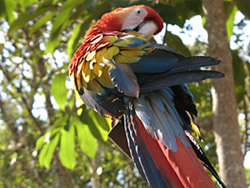 Brilliant red macaws lined the entrance gate, completely oblivious to the tourists trickling in. The number seemed to grow every time I glanced at the entrance. It was beautiful, and not just a bit like "The Birds."
Brilliant red macaws lined the entrance gate, completely oblivious to the tourists trickling in. The number seemed to grow every time I glanced at the entrance. It was beautiful, and not just a bit like "The Birds."
I opted not to hire a guide, but one young man particularly wanted to be hired. He was already leading a good-sized group, but he broke away, ran up to me and asked if I was American, then followed me for a while asking eager questions. Eventually he blurted out that I was pretty and hurried back to his group. I don't know why I didn't see that free guided tour coming my way...I probably could have learned something about Copán.
Copán lives up to the description "archaeological park," looking somewhat like an outdoor museum. It's not a dense jungle-covered city creating a sense of discovery on first sight, but rather a site full of roped-off gorgeously intricate sculptures set on a manicured lawn. This isn't a bad thing, it's just a little short on romance. But its relative lack of fame compared to Guatemala's Tikal means it's very easy to wander off and find a spot away from crowds.
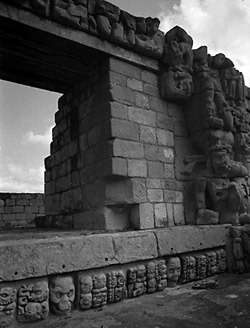 | 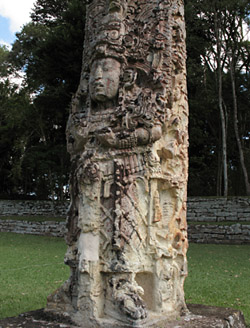 |
Even though I was annoyed at being delayed by the hotel tout, the late start only affected my photos (mostly very flat); it didn't mean the place was teeming with tourists by any means. Starting out with the stepped structures along the perimeter gave me a chance to explore the ruins alone.
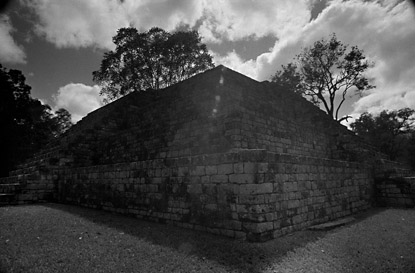 Copán does not feature impressively crafted buildings or pyramids reaching towards the sky, but its delicate sculptures and carvings are its main draw. As the incredibly detailed various stelae and altars in the Great Plaza are the most impressive, most tour groups will be gathered there. Another beautiful sight is the Hieroglyphic Stairway; the 72 steps containing more than 2500 hieroglyphs are permanently under study by archaeologists hoping to read the history of Copán's rulers and are thus covered by a tarp.
Copán does not feature impressively crafted buildings or pyramids reaching towards the sky, but its delicate sculptures and carvings are its main draw. As the incredibly detailed various stelae and altars in the Great Plaza are the most impressive, most tour groups will be gathered there. Another beautiful sight is the Hieroglyphic Stairway; the 72 steps containing more than 2500 hieroglyphs are permanently under study by archaeologists hoping to read the history of Copán's rulers and are thus covered by a tarp.
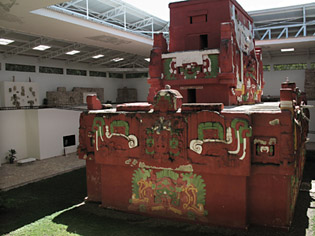 |
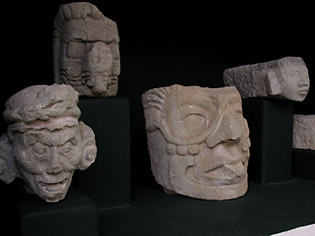 |
I took a break from old stones to enjoy Copán's short "nature trail," which winds through the trees and features various educational signs about the Maya. To my surprise, it eventually led to more old stones, a rather small structure. No one else was on the trail that morning.
The quietest spot was the southernmost grouping of structures. I ambled along a wall with grass growing between its stones and found the forested area with a grouping of low buildings; beautiful, but not dramatic enough to bring more visitors. A friendly groundskeeper told me I was in the cemetario and agreed that there were never many people here. He divulged that it was his favorite part of Copán. It was exactly what I'd hoped to see: dark stained buildings rising out of the woods, overgrown grass covering the lower steps, and the whispery echo of the past.
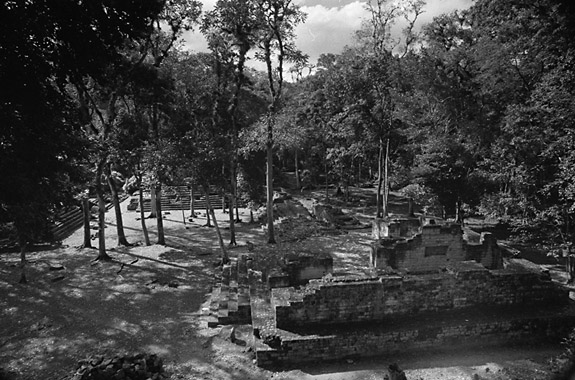
El Cemetario, Copán